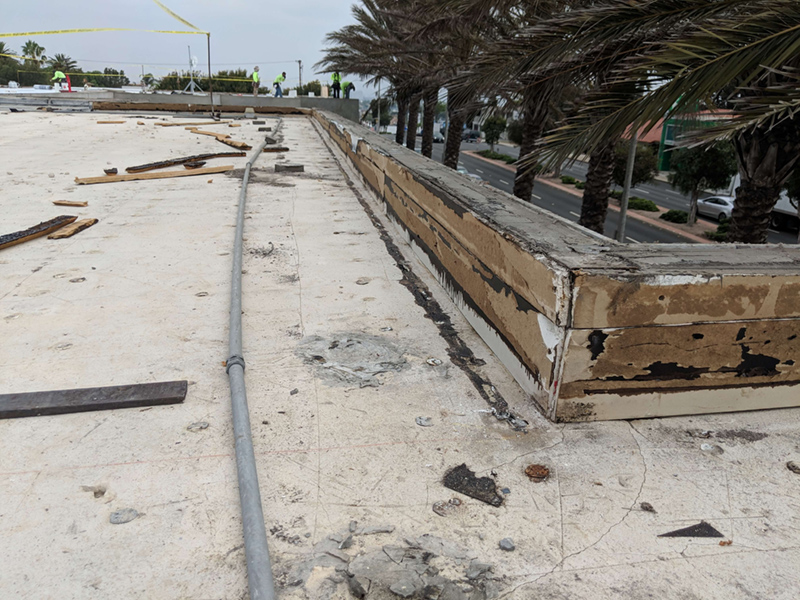5 Causes of Commercial Roof Failures

No roof lasts forever; Mother Nature sees to that. But when it comes to commercial roofing systems, several different factors (or a combination thereof) can cause roofs to fail prematurely. When that happens, it can result in a cascading number of problems, including damage to the interior and indirect damage to the structure itself — not to mention the considerable cost of roof replacement.
Fortunately, many commercial roof failures (though not all) are preventable.
Why Commercial Roofs Fail
The first step in preventing or delaying commercial roof failure is to be aware of the various risk factors. Let’s take a look at five common reasons commercial roofs fail and what can be done to prevent those failures or reduce the risk.
Poor Roof Design
Sadly, many roofing systems are doomed to have a short life expectancy from the very beginning. If the roof system itself is designed or installed with inefficient drainage or moisture management systems, for example, ponding water will encourage the growth of mold and bacteria, which can deteriorate the surface, as well as lead to the rust and corrosion of metallic truss plates, and flashing, etc. Another common issue is blistering, caused by water vapor becoming trapped within the roof layers.
Quite often, poor roof design is tied to the building structure itself, not the actual roof installation. Without proper ventilation from within, warm water vapor rises from inside the building and condenses and collects under the cool membrane. If the building or the roof deck is poorly designed, even the highest quality roof installations won’t last as long as they should.
Preventative measures
The best prevention comes at the design stage for these problems. Make sure the roof has enough slope for adequate drainage, and watch for potential areas of ponding. Install a proper ventilation system in the attic/rafters to allow moisture to escape rather than collect.
Aging/Deterioration
Even the best commercial roof systems will eventually fail due to aging and/or deterioration. However, certain factors can cause roof systems to “age” more quickly — for example, dirt and debris collection, mold growth, excessive foot traffic, etc.
Preventative measures
Regular roof cleaning, maintenance, and inspections are the best preventative against premature roof aging. Membrane roofs should be cleaned periodically with mild detergent and a low-pressure wash to remove dirt, debris, and mold.
Regular inspections of the surface, seams, joints, and flashing will reveal possible leakage areas so repairs and reinforcements can be made quickly.
Environmental Factors
Here is where natural elements often have the final word on a roof’s life expectancy. In some cases, roof failure can be avoided by being responsive and proactive; in some severe cases, however, failure is unavoidable.
The most common environmental factors that can cause roof failure are:
- Wind damage. High winds (typically from a storm) dislodge the roofing material from the roof deck.
- Water intrusion. Leaks emerge during consistent precipitation due to unseen vulnerabilities in the seams, joints, or flashing, causing additional deterioration once water intrudes.
- Standing water. Excessive rain, combined with either poor installation or the aging process, results in excess standing water on the roof, accelerating deterioration.
- Thermal cycling. Extreme shifts between hot and cold temperatures can weaken the roofing materials can cause cracking — both seasonally and when they occur days apart.
- Excessive heat. Long heat waves can accelerate roof deterioration.
- Impacts. Falling debris or hail can cause punctures and tears of the membrane.
- Pollutants. Exposure to toxic chemicals and air pollution can weaken the integrity of the roof.
Preventative measures
Responsiveness is key when Mother Nature strikes. Be sure to inspect the roof after major weather events and conduct repairs as needed to prevent cascading damage. Additionally, using roofing materials appropriate to the climate or environment can help extend a roof’s life. For example, TPO roofing does better than PVC in cold climates, while PVC roofing is more resistant to pollutants and high winds.
Substandard Workmanship
It is possible to choose the best roofing materials possible, take all precautions with design, and still have the roof system fail because it wasn’t installed properly.
Common installation missteps include insufficient adhesives, inconsistent heat-sealing, improperly installed flashings and joints, etc. Workmanship failures can also occur during normal repairs and maintenance, and faulty work can create a new problem where one didn’t exist before.
Preventative measures
When working with commercial roofing materials, always pay close attention to the manufacturer’s instructions on installing the materials. Also, make sure anyone who works on the roof has the required skillset, and ensure they are specifically trained on installation procedures for the materials you’re using.
Low-Quality Materials
Sadly, with an abundance of roofing manufacturers out there, not all of them maintain high levels of quality control. As a result, many commercial roofs are made from subpar materials, inherently prone to punctures, tears, leaks, and premature deterioration. They are, therefore, all but destined to fail early and often. Not even the best craftsmanship can compensate for faulty roofing materials.
Preventative measures
Only choose roofing materials and systems made by manufacturers you know and trust. When in doubt, consulting with a manufacturer representative like RoofSource can help.
The Right Resources to Avoid Commercial Roof Failure
One of the primary benefits of working with RoofSource is that we represent only top-tier manufacturers with a proven track record of success. Our experts can also help you make informed decisions about the right commercial roofing materials for your project. They can advise on how to install/maintain them so you can reduce the risks of early failure and ensure the longest possible life expectancy for your roof. Contact us today to get started.
